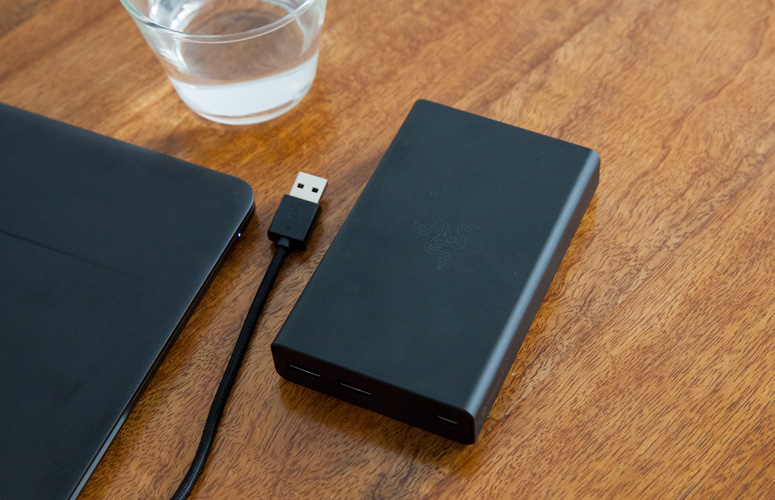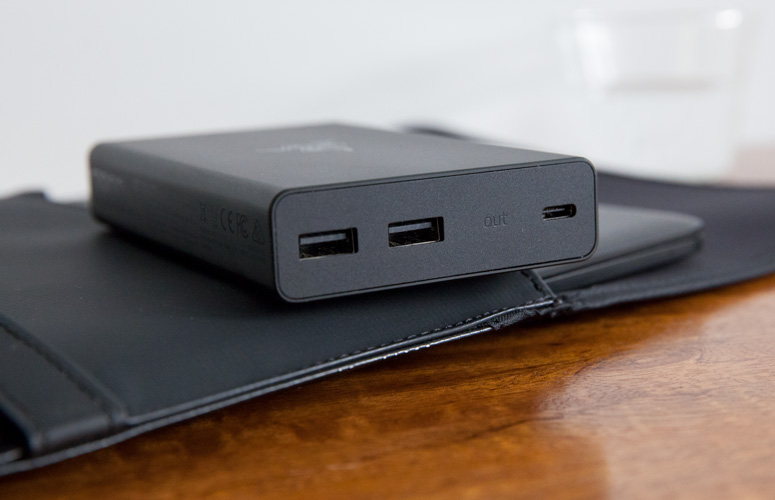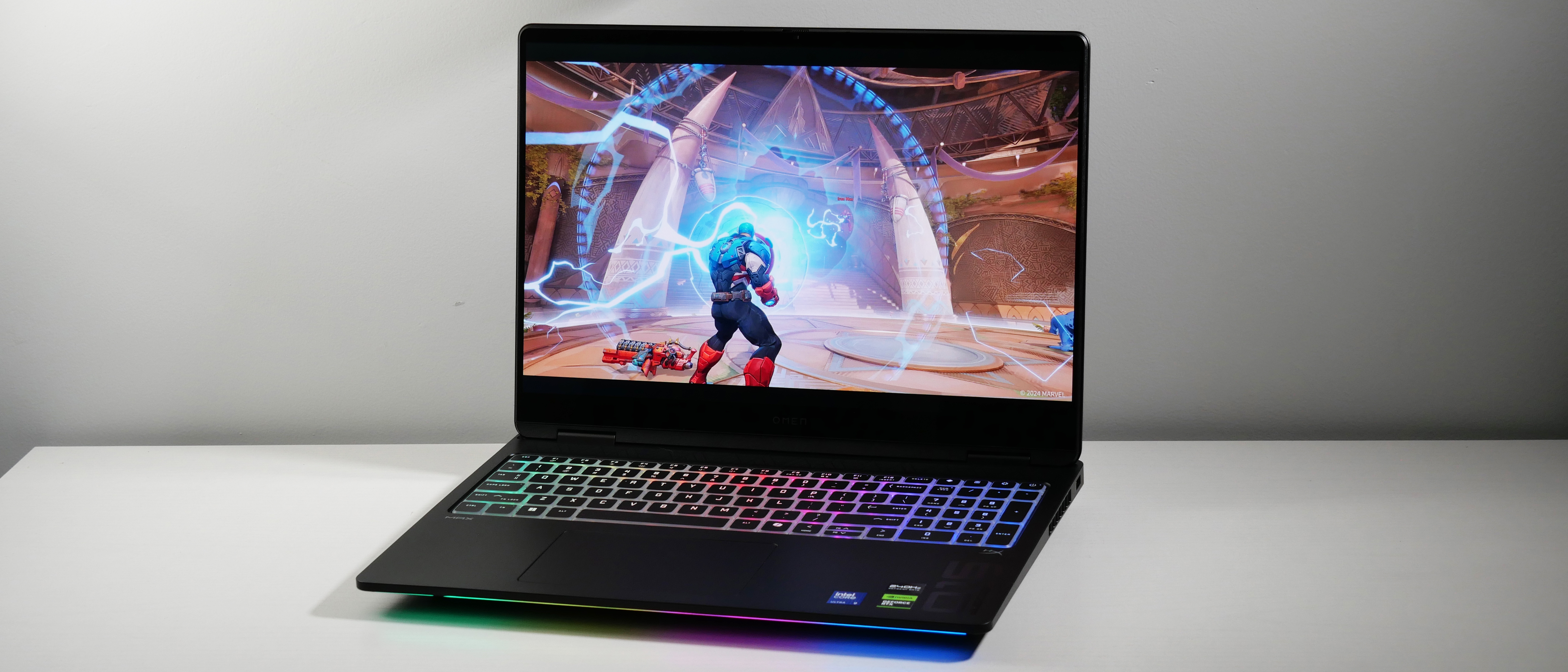Laptop Mag Verdict
The Razer Power Bank uses Qualcomm Quick Charge technology to quickly and intelligently charge nearly all your mobile devices.
Pros
- +
Sleek, lightweight design
- +
Works with most USB Type-C powered laptops
- +
Has Qualcomm Quick Charge 3.0 technology
Cons
- -
A tad pricey
Why you can trust Laptop Mag
For those of us who are constantly on the go, there's nothing worse than looking at your laptop or phone and discovering you've got only 15 percent of battery life. From there, you're forced to make difficult choices. Do you fire off that last email, or watch a few more fail videos? With the Razer Power Bank, a low battery can be a thing of the past. Wrapped in sleek black aluminum, the 12,800-milliamp portable charger can charge smartphones and tablets quickly, thanks to its Qualcomm Quick Charge 3.0 technology. And if you happen to own a USB Type-C powered laptop, you can plug it in and get several hours more of battery life. However, the $149.99 price might give all but the most tech-addicted among us pause.
Design
It's just not a Razer Blade product unless it's swathed in stately black CNC aluminum. So I wasn't in the least bit surprised when I took the Power Bank out of its packaging. Keeping with the Razer aesthetic, the Power Bank even has the three-headed snake emblem stamped on the top of the device, minus the eerie green glow. That doesn't mean, however, that the Power Bank is just a slab of black metal.

On the contrary, the emblem and pertinent information like milliamps and wattage are printed in a glossy material that catches the light and your eye. Same goes for the large circular power button along the bottom. Pressing the button shows off the four green status lights that indicate how much juice the portable battery has.
MORE: Best USB Type-C Accessories and Cables
Despite its aluminum shell, the 4.95 x 3.1 x 0.92-inch portable battery weighs only 11.8 ounces. The 6.4 x 3.1 x 0.8-inch Dell Power Companion, which is made of black plastic, is noticeably heavier at 14.8 ounces. Although it's a bit thick, the Power Bank slid easily into my front jeans pocket -- I just wouldn't place the charger and my phone in there. Since it's a lot longer, a sizable portion of the Power Companion protruded from my pocket.
Ports
Most portable chargers have only one or two ports with which to give and receive power. Not so with the Power Bank. Razer very wisely added three ports to the top and bottom of the charger. The top end of the device is where you'll be charging your smartphone, headphones and, in some cases, laptop. You'll find a pair of USB 3.0 ports along with a USB Type-C port. The bottom is where you'll replenish the Power Bank's battery with either a USB Type-C port or a microUSB port. The Power Bank can also be charged via an optional AC adapter.

The Dell Power Companion also has a number of top-mounted ports. There are two USB 3.0 ports, jacks for an AC adapters and a proprietary port for optional attachments, including a USB Type-C cable or a Type-C to HDMI adapter.
Performance
As a person who can't stand being without my smartphone, I have almost as many chargers as headphones. That said, the Power Bank might be one of the strongest chargers I've had the pleasure of using. Thanks to its 12,800 mAH battery, the device can charge up to three products simultaneously, which came in handy when I needed to charge a pair of wireless headphones, my Nintendo Switch and my Samsung Galaxy S8+.
But the Power Bank made its biggest impression when I attached it to a couple of laptops: the Razer Blade Stealth and the Lenovo ThinkPad Yoga 370. We ran the Laptop Mag Battery test, which consists of continuous web surfing over Wi-Fi. By itself, the Blade Stealth lasted 5 hours and 11 minutes, but with the Power Bank attached, the ultraportable tapped out after 10:10. That's an additional 4 hours and 49 minutes. When we switched over to the Yoga 370, the Power Bank extended the battery test for an additional 3 hours and 2 minutes, bringing the laptop's original time of 7:25 to 10:27.
MORE: Longest Battery Life Laptops
We tried running the same tests with the Dell Power Companion. But despite the charger'shaving a 12,000-mAH battery, we discovered that the charger isn't designed to support non-Dell laptops. When we tried connecting it to the Blade Stealth, we received an error that the attached USB device wasn't recognized. While the Yoga 370 did acknowledge the charger, it couldn't draw enough power to do more than maintain the notebook at its current power level.
Quick Charge
Razer incorporated Qualcomm's Quick Charge 3.0 technology into the Power Bank for faster charging. Qualcomm claims that its technology can charge devices up to four times faster than conventional chargers.

It took about 45 minutes to bring my S8+ to full charge from 66 percent, while my old Braven BRVPBG08 Rugged Portable Charger ($45.99, 6,000 mAH) took 1 hour and 24 minutes to deliver the same amount of charge. In addition to faster charging, Quick Charge also supports a variety of voltage options, dynamically adjusting according to whichever device is plugged in.
Bottom Line
The Razer Power Bank is my new favorite charger. Thanks to this device, I can charge my phone, headphones and ultraportable laptop without looking for power outlets-- which can be few and far between when I'm on the go. The 12,800 mAH battery serves up tons of power, and with Qualcomm's Quick Charge technology, I can also expect a fully charged phone in a relatively short time. Plus, with that black CNC aluminum, it has a more premium look than other chargers on the market. The $149.99 price is a bit steep, but for what it can do, the Razer Power Bank should be on every mobile professional's list.
Razer Power Bank Specs
| Accessories Type | Chargers |
| Battery Type/Life | 12,800mAh battery |
| Brand | Razer |
| Company Website | http://www.razerzone.com |
| Size | 4.95 x 3.08 x 0.92 inches |
| Weight | 0.74 pounds |

Sherri L. Smith has been cranking out product reviews for Laptopmag.com since 2011. In that time, she's reviewed more than her share of laptops, tablets, smartphones and everything in between. The resident gamer and audio junkie, Sherri was previously a managing editor for Black Web 2.0 and contributed to BET.Com and Popgadget.
